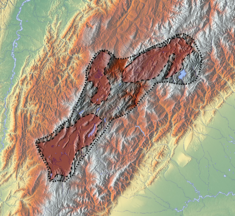Muisca astronomy
|
Read other articles:

No debe confundirse con la antigua República Popular de Corea ni con la República Popular Democrática de Corea (Corea del Norte). República de Corea대한민국 (coreano)Daehan MingukBandera Emblema nacional Himno: 애국가 Aegukga(«La canción patriótica») ¿Problemas al reproducir este archivo? Territorio controlado por la República de Corea en verde oscuro; territorio reclamado pero no controlado en verde claro.Capital Seúl (de iure) Sejong (de facto) 37°34′N 126°59�…

Questa voce o sezione sull'argomento società calcistiche serbe non cita le fonti necessarie o quelle presenti sono insufficienti. Puoi migliorare questa voce aggiungendo citazioni da fonti attendibili secondo le linee guida sull'uso delle fonti. Questa voce sull'argomento società calcistiche serbe è solo un abbozzo. Contribuisci a migliorarla secondo le convenzioni di Wikipedia. FK Mladost LučaniCalcio Segni distintiviUniformi di gara Casa Trasferta Colori sociali Bianco, blu Dati …

Railway station in Henan, China Mianchi South railway station Mianchi South railway station (Chinese: 渑池南站) is a railway station located in Mianchi County, Henan, China. It was opened on 6 February 2010, along with the Zhengzhou–Xi'an high-speed railway.[1] References ^ Completion Report Zhengzhou‒Xi'an Railway Project 37487-013 (PDF). ADB. Retrieved 8 August 2020. Preceding station China Railway High-speed Following station Luoyang Longmentowards Zhengzhou Zhengzhou–Xi…

Salsa di soiaSalsa di soia della tipica marca KikkomanOriginiLuogo d'origine Cina DiffusioneAsia DettagliCategoriasalsa Ingredienti principalisemi di soia La salsa di soia (in cinese 醬油T, 酱油S, jiàng yóuP, in coreano 간장?, ganjangLR, kanjangMR, in giapponese: 醤油?, shōyu) è una salsa fermentata ottenuta dalla soia (19%), grano tostato (15,99%), acqua (53%), sale (12%) e Aspergillus sp. (<0,01%). Originaria della Cina, la salsa di soia è un comune ingrediente del…

Pakistani TV series or programme Ru Baru Ishq ThaTitle card of serialGenreSerial drama Romantic serialCreated byTNI ProductionsDeveloped byTNI ProductionsWritten byAmber AzharScreenplay byAmber AzharDirected byFurqan KhanStarring Danish Taimoor Ushna Shah Sanam Chaudhry Opening themeSinger: Nabeel Shaukat AliCountry of originPakistanOriginal languageUrduNo. of seasons1No. of episodes26ProductionProducer Zeeshan Khan Production location Pakistan Camera setupMulti-camera setupProduction companyTNI…

American college basketball season 1932–33 Duke Blue Devils men's basketballConferenceSouthern ConferenceRecord17–5 (7–3 Southern)Head coachEddie CameronHome arenaCard GymnasiumSeasons← 1931–321933–34 → 1932–33 Southern Conference men's basketball standings vte Conf Overall Team W L PCT W L PCT South Carolina † 4 – 0 1.000 17 – 2 .895 Duke 7 – 3 .700 17 – 5 .773 Maryland …

Muamer Tanković Informasi pribadiNama lengkap Muamer TankovićTanggal lahir 22 Februari 1995 (umur 29)Tempat lahir Norrköping, SwediaTinggi 181 cm (5 ft 11 in)Posisi bermain Sayap / PenyerangInformasi klubKlub saat ini AEK AthenaNomor 22Karier junior2003–2004 Hageby IF2005–2011 IFK Norrköping2011–2013 FulhamKarier senior*Tahun Tim Tampil (Gol)2013–2014 Fulham 3 (0)2014–2017 AZ 58 (10)2016–2017 → Jong AZ 8 (8)2017–2020 Hammarby 84 (29)2020– AEK Athena 30 (…

1969 film by Burt Kennedy This article needs additional citations for verification. Please help improve this article by adding citations to reliable sources. Unsourced material may be challenged and removed.Find sources: The Good Guys and the Bad Guys – news · newspapers · books · scholar · JSTOR (February 2016) (Learn how and when to remove this message) The Good Guys and the Bad GuysFilm posterDirected byBurt KennedyWritten byRonald M. CohenDennis Shrya…

Навчальний центр НГ України Нарукавний знак центруКраїна УкраїнаНалежність Національна гвардіяБазування Львівська область,м.ЗолочівОборонець Василь ВишиванийВійни/битви Російська збройна агресія проти України Війна на сході УкраїниКомандуванняПоточнийко�…

Super Tokkyū (スーパー特急) is the name given to the concept of building new high-speed narrow gauge (1,067 mm (3 ft 6 in)) railway lines in Japan to extend the Shinkansen network of high-speed lines.[1] No Super Tokkyū routes have actually been built. Concept The Super Tokkyū concept involves building new narrow-gauge lines along the routes of planned Shinkansen lines. All infrastructure would be built to high-speed Shinkansen standards, including its wider …

Dalam matematika, khususnya di cabang matematika kombinatorik, kaidah pencacahan merupakan aturan untuk menghitung banyaknya susunan obyek-obyek tanpa harus merinci semua kemungkinan susunannya.[1] Kaidah pencacahan biasanya meliputi aturan dasar menghitung (seperti aturan penjumlahan dan aturan perkalian), prinsip inklusi-eksklusi, pembuktian bijektif, perhitungan ganda, prinsip rumah burung, fungsi pembangkit, dan relasi rekurensi. Aturan dasar menghitung Aturan dasar menghitung melipu…

President of India from 1987 to 1992 R. Venkataraman redirects here. For the Indian cricketer, see R. Venkataraman (Indian cricketer). In this Indian name, the name Ramaswamy is a patronymic, and the person should be referred to by the given name, Venkataraman. Ramaswamy VenkataramanOfficial portrait8th President of IndiaIn office25 July 1987 – 25 July 1992Prime MinisterRajiv GandhiV. P. SinghChandra ShekharP. V. Narasimha RaoVice PresidentShankar Dayal SharmaPreceded byZail SinghSucc…

Part of a series on theEastern Orthodox ChurchMosaic of Christ Pantocrator, Hagia Sophia Overview Structure Theology (History of theology) Liturgy Church history Holy Mysteries View of salvation View of Mary View of icons Background Crucifixion / Resurrection / Ascensionof Jesus Christianity Christian Church Apostolic succession Four Marks of the Church Orthodoxy Organization Autonomy Autocephaly Patriarchate Ecumenical Patriarch Episcopal polity Canon law Clergy Bishops P…

Australian model and actress Megan GaleMegan Gale at the 2015 Cannes Film FestivalBornMegan Kate Gale (1975-08-07) 7 August 1975 (age 48)Parmelia, Western Australia, AustraliaOccupation(s)Model, actressYears active1993−presentPartner(s)Shaun Hampson(2011–present)Children2Modeling informationHeight182 cm (5 ft 11 3/4 in)Hair colorBrownEye colorGreenAgencyChic Celebrity Management, Atelier Management Megan Kate Gale (born 7 August 1975) is an Australian model and actre…

Ballistic missile with a range of about 1,000 kilometres A short-range ballistic missile (SRBM) is a ballistic missile with a range of about 1,000 km (620 mi) or less.[1] In past and potential regional conflicts, these missiles have been and would be used because of the short distances between some countries and their relative low cost and ease of configuration. In modern terminology, SRBMs are part of the wider grouping of theatre ballistic missiles, which includes any ballist…

يفتقر محتوى هذه المقالة إلى الاستشهاد بمصادر. فضلاً، ساهم في تطوير هذه المقالة من خلال إضافة مصادر موثوق بها. أي معلومات غير موثقة يمكن التشكيك بها وإزالتها. (ديسمبر 2018) بطولة العالم للدراجات على المضمار 1933 التفاصيل التاريخ 1933 الموقع فرنسا (باريس) نوع السباق سباق الدراجات …

1985 single by Paul Kelly From St Kilda to Kings CrossSingle by Paul Kellyfrom the album Post A-sideFrom St Kilda to Kings CrossB-sideBlues for SkipReleasedApril 1985RecordedJanuary–February 1985Silverwood Studios, SydneyGenreFolk rockLength2:53LabelWhiteSongwriter(s)Paul KellyProducer(s)Paul Kelly, Clive ShakespearePaul Kelly singles chronology Rocking Institution From St Kilda to Kings Cross (1985) Before Too Long (1986) Audio sampleFrom St Kilda to Kings Crossfilehelp From St Kilda to Kings…

Polish poet, journalist, playwright, comedy writer and songwriter Marian HemarBornMarian Hescheles(1901-04-06)6 April 1901Lwów (now Lviv, Ukraine)Died11 February 1972(1972-02-11) (aged 70)Dorking, United KingdomOccupationWriterLanguagePolishNationalityPolish Marian Hemar (1901–1972), born Marian Hescheles (other pen names: Jan Mariański, and Marian Wallenrod), was a Polish poet, journalist, playwright, comedy writer, and songwriter. Hemar himself stated that before the outbreak of World…

معركة الفلوجة الأولى جزء من الاحتلال الأمريكي للعراق محاولة القوات الأمريكية السيطرة على الفلوجة معلومات عامة التاريخ 4 ابريل 2004 - 1 مايو 2004 البلد العراق من أسبابها الغزو الامريكي للعراق الموقع الأنبار، الفلوجة33°21′00″N 43°47′00″E / 33.35°N 43.783333°E / 33.35; 43.783333 ال…

多古町多谷町町日文轉寫 • 日文多谷町 • 平假名たこまち • 罗马字Tako-machi松崎神社(坂東稻荷本宮) 町旗多古町在千葉縣的位置多古町多古町在日本的位置坐标:35°44′08″N 140°28′04″E / 35.73561°N 140.46775°E / 35.73561; 140.46775国家 日本地方關東地方都道府縣千葉縣接鄰行政區匝瑳市、香取市、成田市、山武郡芝山町、横芝光町面…







